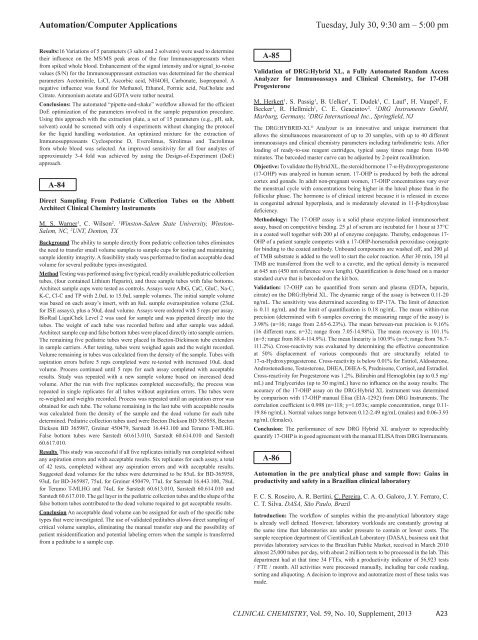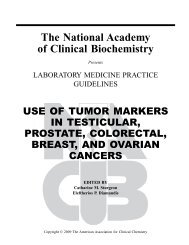Abstracts of the Scientific Posters, 2013 AACC Annual Meeting ...
Abstracts of the Scientific Posters, 2013 AACC Annual Meeting ...
Abstracts of the Scientific Posters, 2013 AACC Annual Meeting ...
Create successful ePaper yourself
Turn your PDF publications into a flip-book with our unique Google optimized e-Paper software.
Automation/Computer Applications<br />
Tuesday, July 30, 9:30 am – 5:00 pm<br />
Results:16 Variations <strong>of</strong> 5 parameters (3 salts and 2 solvents) were used to determine<br />
<strong>the</strong>ir influence on <strong>the</strong> MS/MS peak areas <strong>of</strong> <strong>the</strong> four Immunosuppressants when<br />
from spiked whole blood. Enhancement <strong>of</strong> <strong>the</strong> signal intensity and/or signal_to-noise<br />
values (S/N) for <strong>the</strong> Immunosuppressant extraction was determined for <strong>the</strong> chemical<br />
parameters Acetonitrile, LiCI, Ascorbic acid, NH4OH, Carbonate, Isopropanol. A<br />
negative influence was found for Methanol, Ethanol, Formic acid, NaCholate and<br />
Citrate. Ammonium acetate and GDTA were ra<strong>the</strong>r neutral.<br />
Conclusions: The automated “pipette-and-shake” workflow allowed for <strong>the</strong> efficient<br />
DoE optimization <strong>of</strong> <strong>the</strong> parameters involved in <strong>the</strong> sample preparation procedure.<br />
Using this approach with <strong>the</strong> extraction plate, a set <strong>of</strong> 15 parameters (e.g., pH, salt,<br />
solvent) could be screened with only 4 experiments without changing <strong>the</strong> protocol<br />
for <strong>the</strong> liquid handling workstation. An optimized mixture for <strong>the</strong> extraction <strong>of</strong><br />
Immunosuppressants Cyclosporine D, Everolimus, Sirolimus and Tacrolimus<br />
from whole blood was selected. An improved sensitivity for all four analytes <strong>of</strong><br />
approximately 3-4 fold was achieved by using <strong>the</strong> Design-<strong>of</strong>-Experiment (DoE)<br />
approach.<br />
A-84<br />
Direct Sampling From Pediatric Collection Tubes on <strong>the</strong> Abbott<br />
Architect Clinical Chemistry Instruments<br />
M. S. Warner 1 , C. Wilson 2 . 1 Winston-Salem State University, Winston-<br />
Salem, NC, 2 UNT, Denton, TX<br />
Background The ability to sample directly from pediatric collection tubes eliminates<br />
<strong>the</strong> need to transfer small volume samples to sample cups for testing and maintaining<br />
sample identity integrity. A feasibility study was performed to find an acceptable dead<br />
volume for several peditube types investigated.<br />
Method Testing was performed using five typical, readily available pediatric collection<br />
tubes, (four contained Lithium Heparin), and three sample tubes with false bottoms.<br />
Architect sample cups were tested as controls. Assays were AlbG, CaC, GluC, Na-C,<br />
K-C, Cl-C and TP with 2.0uL to 15.0uL sample volumes. The initial sample volume<br />
was based on each assay’s insert, with an 8uL sample overaspiration volume (23uL<br />
for ISE assays), plus a 50uL dead volume. Assays were ordered with 5 reps per assay.<br />
BioRad LiquiChek Level 2 was used for sample and was pipetted directly into <strong>the</strong><br />
tubes. The weight <strong>of</strong> each tube was recorded before and after sample was added.<br />
Architect sample cup and false bottom tubes were placed directly into sample carriers.<br />
The remaining five pediatric tubes were placed in Becton-Dickinson tube extenders<br />
in sample carriers. After testing, tubes were weighed again and <strong>the</strong> weight recorded.<br />
Volume remaining in tubes was calculated from <strong>the</strong> density <strong>of</strong> <strong>the</strong> sample. Tubes with<br />
aspiration errors before 5 reps completed were re-tested with increased 10uL dead<br />
volume. Process continued until 5 reps for each assay completed with acceptable<br />
results. Study was repeated with a new sample volume based on increased dead<br />
volume. After <strong>the</strong> run with five replicates completed successfully, <strong>the</strong> process was<br />
repeated in single replicates for all tubes without aspiration errors. The tubes were<br />
re-weighed and weights recorded. Process was repeated until an aspiration error was<br />
obtained for each tube. The volume remaining in <strong>the</strong> last tube with acceptable results<br />
was calculated from <strong>the</strong> density <strong>of</strong> <strong>the</strong> sample and <strong>the</strong> dead volume for each tube<br />
determined. Pediatric collection tubes used were Becton Dickson BD 365958, Becton<br />
Dickson BD 365987, Greiner 450479, Sarstedt 16.443.100 and Terumo T-MLHG.<br />
False bottom tubes were Sarstedt 60.613.010, Sarstedt 60.614.010 and Sarstedt<br />
60.617.010.<br />
Results This study was successful if all five replicates initially run completed without<br />
any aspiration errors and with acceptable results. Six replicates for each assay, a total<br />
<strong>of</strong> 42 tests, completed without any aspiration errors and with acceptable results.<br />
Suggested dead volumes for <strong>the</strong> tubes were determined to be 85uL for BD-365958,<br />
93uL for BD-365987, 75uL for Greiner 450479, 77uL for Sarstedt 16.443.100, 78uL<br />
for Terumo T-MLHG and 74uL for Sarstedt 60.613.010, Sarstedt 60.614.010 and<br />
Sarstedt 60.617.010. The gel layer in <strong>the</strong> pediatric collection tubes and <strong>the</strong> shape <strong>of</strong> <strong>the</strong><br />
false bottom tubes contributed to <strong>the</strong> dead volume required to get acceptable results.<br />
Conclusion An acceptable dead volume can be assigned for each <strong>of</strong> <strong>the</strong> specific tube<br />
types that were investigated. The use <strong>of</strong> validated peditubes allows direct sampling <strong>of</strong><br />
critical volume samples, eliminating <strong>the</strong> manual transfer step and <strong>the</strong> possibility <strong>of</strong><br />
patient misidentification and potential labeling errors when <strong>the</strong> sample is transferred<br />
from a peditube to a sample cup.<br />
A-85<br />
Validation <strong>of</strong> DRG:Hybrid XL, a Fully Automated Random Access<br />
Analyzer for Immunoassays and Clinical Chemistry, for 17-OH<br />
Progesterone<br />
M. Herkert 1 , S. Passig 1 , B. Uelker 1 , T. Dudek 1 , C. Lauf 1 , H. Vaupel 1 , F.<br />
Becker 1 , R. Hellmich 1 , C. E. Geacintov 2 . 1 DRG Instruments GmbH,<br />
Marburg, Germany, 2 DRG International Inc., Springfi eld, NJ<br />
The DRG:HYBRID-XL ® Analyzer is an innovative and unique instrument that<br />
allows <strong>the</strong> simultaneous measurement <strong>of</strong> up to 20 samples, with up to 40 different<br />
immunoassays and clinical chemistry parameters including turbidimetric tests. After<br />
loading <strong>of</strong> ready-to-use reagent cartridges, typical assay times range from 10-90<br />
minutes. The barcoded master curve can be adjusted by 2-point recalibration.<br />
Objective: To validate <strong>the</strong> Hybrid XL, <strong>the</strong> steroid hormone 17-α-Hydroxyprogesterone<br />
(17-OHP) was analyzed in human serum. 17-OHP is produced by both <strong>the</strong> adrenal<br />
cortex and gonads. In adult non-pregnant women, 17-OHP concentrations vary over<br />
<strong>the</strong> menstrual cycle with concentrations being higher in <strong>the</strong> luteal phase than in <strong>the</strong><br />
follicular phase. The hormone is <strong>of</strong> clinical interest because it is released in excess<br />
in congenital adrenal hyperplasia, and is moderately elevated in 11-β-hydroxylase<br />
deficiency.<br />
Methodology: The 17-OHP assay is a solid phase enzyme-linked immunosorbent<br />
assay, based on competitive binding. 25 μl <strong>of</strong> serum are incubated for 1 hour at 37°C<br />
in a coated well toge<strong>the</strong>r with 200 μl <strong>of</strong> enzyme conjugate. Thereby, endogenous 17-<br />
OHP <strong>of</strong> a patient sample competes with a 17-OHP-horseradish peroxidase conjugate<br />
for binding to <strong>the</strong> coated antibody. Unbound components are washed <strong>of</strong>f, and 200 μl<br />
<strong>of</strong> TMB substrate is added to <strong>the</strong> well to start <strong>the</strong> color reaction. After 30 min, 150 μl<br />
TMB are transferred from <strong>the</strong> well to a cuvette, and <strong>the</strong> optical density is measured<br />
at 645 nm (450 nm reference wave length). Quantification is done based on a master<br />
standard curve that is barcoded on <strong>the</strong> kit box.<br />
Validation: 17-OHP can be quantified from serum and plasma (EDTA, heparin,<br />
citrate) on <strong>the</strong> DRG:Hybrid XL. The dynamic range <strong>of</strong> <strong>the</strong> assay is between 0.11-20<br />
ng/mL. The sensitivity was determined according to EP-17A. The limit <strong>of</strong> detection<br />
is 0.11 ng/mL and <strong>the</strong> limit <strong>of</strong> quantification is 0.18 ng/mL. The mean within-run<br />
precision (determined with 6 samples covering <strong>the</strong> measuring range <strong>of</strong> <strong>the</strong> assay) is<br />
3.98% (n=16; range from 2.65-6.23%). The mean between-run precision is 9.16%<br />
(16 different runs; n=32; range from 7.05-14.98%). The mean recovery is 101.1%<br />
(n=5; range from 88.4-114.9%). The mean linearity is 100.9% (n=5; range from 76.7-<br />
111.2%). Cross-reactivity was evaluated by determining <strong>the</strong> effective concentration<br />
at 50% displacement <strong>of</strong> various compounds that are structurally related to<br />
17-α-Hydroxyprogesterone. Cross-reactivity is below 0.01% for Estriol, Aldosterone,<br />
Androstenedione, Testosterone, DHEA, DHEA-S, Prednisone, Cortisol, and Estradiol.<br />
Cross-reactivity for Progesterone was 1.2%. Bilirubin and Hemoglobin (up to 0.5 mg/<br />
mL) and Triglycerides (up to 30 mg/mL) have no influence on <strong>the</strong> assay results. The<br />
accuracy <strong>of</strong> <strong>the</strong> 17-OHP assay on <strong>the</strong> DRG:Hybrid XL instrument was determined<br />
by comparison with 17-OHP manual Elisa (EIA-1292) from DRG Instruments. The<br />
correlation coefficient is 0.998 (n=118; y=1.053x; sample concentration, range 0.11-<br />
19.86 ng/mL). Normal values range between 0.12-2.49 ng/mL (males) and 0.06-3.93<br />
ng/mL (females).<br />
Conclusion: The performance <strong>of</strong> new DRG Hybrid XL analyzer to reproducibly<br />
quantify 17-OHP is in good agreement with <strong>the</strong> manual ELISA from DRG Instruments.<br />
A-86<br />
Automation in <strong>the</strong> pre analytical phase and sample flow: Gains in<br />
productivity and safety in a Brazilian clinical laboratory<br />
F. C. S. Roseiro, A. R. Bertini, C. Pereira, C. A. O. Galoro, J. Y. Ferraro, C.<br />
C. T. Silva. DASA, São Paulo, Brazil<br />
Introduction: The workflow <strong>of</strong> samples within <strong>the</strong> pre-analytical laboratory stage<br />
is already well defined. However, laboratory workloads are constantly growing at<br />
<strong>the</strong> same time that laboratories are under pressure to contain or lower costs. The<br />
sample reception department <strong>of</strong> CientíficaLab Laboratory (DASA), business unit that<br />
provides laboratory services to <strong>the</strong> Brazilian Public Market, received in March 2010<br />
almost 25,000 tubes per day, with about 2 million tests to be processed in <strong>the</strong> lab. This<br />
department had at that time 34 FTEs, with a productivity indicator <strong>of</strong> 56,923 tests<br />
/ FTE / month. All activities were processed manually, including bar code reading,<br />
sorting and aliquoting. A decision to improve and automatize most <strong>of</strong> <strong>the</strong>se tasks was<br />
made.<br />
CLINICAL CHEMISTRY, Vol. 59, No. 10, Supplement, <strong>2013</strong><br />
A23
















